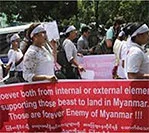THE flight of the Rohingyas from Myanmar has now received global attention, and what began as an internal political issue in Myanmar has spilled into the’ Asean region. For several years now, there have been reports of growing ethnic-religious tension in Myanmar as· a result of the rise of right-wing· ethno-nationalist groups, notably the “969” movement, and the rhetoric employed by some
These groups have been calling for a boycott of Muslim-owned businesses in the country, and have been at the forefront of a sustained campaign to depict Muslims as outsiders and aliens in their society. The net result has been the demonisation of Muslims in general and the Rohingyas in particular, whose history as the people of Arakan has been slowly erased. Thus far, this has led to instances of violent attacks against the Rohingyas and has been the main reason for their flight abroad.
For scholars working on the phenomenon of religio-political violence, two factors stand out:
FIRSTLY, the rhetoric used by Buddhist ‘radicals in Myanmar seem similar to the discursive strategies used by non-Buddhist radical groups in other contexts. The manner in which Muslims have been presented as aliens and enemies by the 969 group .is hardly different from the way in which some radical militant Muslim and Christian groups have depicted members of other faith communities, branding them “infidels”; “unbelievers” or “enemies of the faith”. This highlights the fact that most of these radical groups thrive upon a simple dialectical logic of “us against them”, and need to constantly foreground an “other/enemy” community to unite their· own followers. From a structuralist point of view, the similarities between these discourses show that they. are all couched on a narrow form of oppositional dialectics.
SECONDLY, as any scholar of comparative religion will note, nothing about movements such as the 969 group can be said to be based on Buddhism per se, for there has never been a religious justification for murder or persecution of minorities in Buddhism. It is important to note that many Buddhist scholars and activists across the world have also protested against the communal violence in Myanmar, and have insisted that Buddhism has never condoned violence against non-Buddhists.
This crisis affords an opportunity for all religious scholars and leaders to emphasise, yet again, that there is a distinction between religion per se and the use or abuse of religion and religious symbols for political ends. For years, many notable Muslim scholars have been trying to draw a clear distinction between Islam as a religion and the political actions of some radical Muslims who claim that their violence is religiously justified. Today, Buddhist scholars are doing the same, by emphasising that the phenomenon of Buddhist communalism and extremism is not rooted in Buddhism, and that Buddhism should not be blamed for what is happening in such crisis zones. In these cases, both Muslim and Buddhist scholars are anxious to protect what they regard as the sanctity of their beliefs from abuse by political groups, as well as misrepresentation in the media.
The present crisis thus provides an opportunity for moderates of all religious communities to reengage in the dialogue process, as it is vital that instances of Muslim-Buddhist antagonism in one country does not spread to other places where Muslims and Buddhists have been living together for centuries.
As Southeast Asia is the home of almost every major religious community in the world, there is the need to be aware of such developments iIi and outside the region, and to put in place channels of dialogue, education and understanding that may serve as circuit breakers in times of communal tension. But above all, the present crisis should remind political analysts that, when examining instances of communal conflict, one should do so through the lens of politics and political contestation.
All religious discourses can -and have been -“hijacked” at some time or another by political groups to serve political ends. Though the language and symbols of religion may be used to add a superficial gloss of legitimacy or justification for such acts of communal violence, the religious justification is at surface-level only. Just because a community is attacked or harassed in the name of a particular religion does not mean that that entire religious-belief system is at fault, or that belonging to that religious community immediately and necessarily implicates every believer in the same communal violence.
There are often other non-religious factors and agendas at work as well; be it the desire for political dominance, economic leverage, mass mobilisation of support, etc. The underlying political economy of communal/ethnic violence is still the mainframe through which such conflicts occur, and here it is vital to pinpoint the actors involved and their agendas, rather than delving into obscure and perhaps irrelevant discussions on theology or cosmology.
Article by Dr Farish Noor which appeared in New Straits Times, 1 June 2015.





